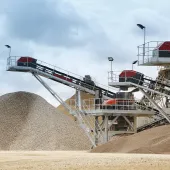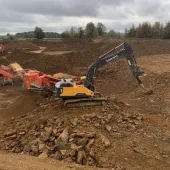Quarry restoration and waste recovery

First published in the May 2016 issue of Quarry Management as Waste Not – Want Not
By Gregory Jones QC and Charles Streeten1
Just outside the Yorkshire village of Methley, near Leeds, is a former quarry. For decades, Lafarge Aggregates (now Tarmac) had worked and won sand and gravel from the quarry, and on 2 April 2012 Leeds City Council (the relevant mineral and waste planning authority) granted planning permission for an extension to the quarry, permitting the extraction of a further 432,700 tonnes of material.
The terms of that planning permission required the extraction to be carefully phased to retain a footpath (No. 51) across the site for as long as possible (with excavation on both sides leaving the footpath to run along a land bridge). The conditions also required a full restoration scheme re-establishing the footpath and providing ‘positive long-term benefits’ in the form of water-based nature conservation habitats. The details of the scheme even had to be reworked at the request of Leeds City Council so as to provide greater environmental benefit to the local residents and, in particular, to reinstate footpath No. 51 so that residents had access between wetland areas. The restoration of the quarry was seen, both by the Council and the operator, as an opportunity to give something back to benefit the community that had lived near the quarry for so many years.
It is important to note that a fundamental principle of planning law is that a planning condition can only lawfully be imposed if it is necessary (Newbury DC v Secretary of State for the Environment [1981] AC 578). This was how the proposed benefit of the restoration scheme had been secured – restoration in accordance with the proposal was, therefore, necessary.
The permit application
The issue in the Tarmac case concerns the status of the material to be used to execute the restoration scheme. Tarmac proposed (as they had done in the 2012 planning application to which the Environment Agency had not objected) to use waste material to rebuild the land bridge, atop which the restored footpath No. 51 would run, and to provide the morphological remodelling required to separate the shallows and reed beds to be provided on one side of the footpath from the deep fishing lake on the other. Tarmac believed the use of this waste constituted a ‘recovery’ operation within the meaning of Directive 2008/98/EC (the Waste Framework Directive) and therefore applied to the Environment Agency for a ‘standard rules’ SR2010No8_100Kte Use of waste in construction recovery permit to carry out the operation.
The Environment Agency (EA) refused the permit application. Their Recovery v Disposal Advice record (RADA) based its reasoning not so much on the test under the Directive as the EA’s own guidance document EPR 13. The reasoning of the RADA in answering the questions under EPR13 is, to say the least, a little confused. In relation to whether there is a clear benefit from the activity, the answer given is ‘no’. But regarding whether waste is being used as a substitute for non-waste material, the answer given is ‘yes’. The EA, therefore, refused a standard rules permit on the basis that the operation was neither waste recovery nor construction.
The inquiry
Tarmac appealed the decision to the Secretary of State for Environment, Food and Rural Affairs. Following a public inquiry the inspector held that the operation was a construction operation. He also held that EPR 13 was liable to lead to an approach that did not align with the approach to recovery under the Directive. In particular, it appeared to misunderstand that the ‘benefit’ in a recovery operation is the substitution of waste materials for non-waste materials. No other benefit is necessary. Nevertheless, for reasons that are not entirely clear, the inspector refused Tarmac’s appeal.
The above decisions are, perhaps, especially surprising in light of the Environment Agency’s own decision in relation to Wallasea Island. There the EA had granted parties including the RSPB and the Secretary of State himself a recovery permit for the use of waste to construct a large wetland habitat in the Thames estuary using the waste produced by the Crossrail project. That permit had been granted despite the fact that the Mineral Products Association (MPA) had questioned whether this project would be carried out if non-waste materials could not be used and the EA had accepted that it would not.
The law
Whether an operation constitutes ‘recovery’ or ‘disposal’ is to be determined in accordance with Article 3(15) of the Waste Framework Directive, which states: ‘‘recovery’ means any operation the principal result of which is waste serving a useful purpose by replacing other materials which would otherwise have been used to fulfil a particular function, or waste being prepared to fulfil that function, in the plant or in the wider economy. Annex II sets out a non-exhaustive list of recovery operations;….’
The Directive includes annexes setting out non-exhaustive lists of disposal operations (Annex I) and recovery operations (Annex II). D1 of Annex I describes the deposit of waste into or on to land (landfill) as a disposal operation, R10 of Annex II describes land treatment resulting in benefit to agriculture or ecological improvement as a recovery operation.
The Court of Justice of the European Union (CJEU) has previously considered the meaning of waste recovery under previous versions of the Directive. In particular, in case C-6/00 Abfall Service AG (ASA) v Bundesminister fur Umwelt the CJEU held that: ‘the essential characteristic of a waste recovery operation is that its principal objective is that the waste serve a useful purpose in replacing other materials which would have had to be used for that purpose thereby conserving natural resources.’
The meaning of this definition is not, however, entirely clear. On the one hand, it could mean that to constitute recovery, waste must be used in place of non-waste materials as part of a bona fide project, albeit one that would not necessarily take place if non-waste materials were not available (ie, the purpose for which waste materials are replacing non-waste materials is the specific purpose proposed), or it could be confined more tightly so that an operation will constitute recovery only if the operation for which it is used would take place even if non-waste materials were not available. Tarmac argued for the former, the Secretary of State and Environment Agency the latter.
The appeal
Tarmac unsuccessfully challenged the inspector’s decision refusing the appeal in the High Court (R (Lafarge Aggregates Ltd) v (1) Secretary of State for Environment, Food and Rural Affairs (2) Environment Agency [2015] EWHC 2388 (Admin). Tarmac then appealed the decision of the High Court to the Court of Appeal. That appeal was successful (R (Tarmac Aggregates) v SoS Environment [2015] EWCA Civ 1149).
The central issue was whether the inspector’s approach to the planning conditions had been rational. Tarmac argued that it had not. Planning conditions are only lawful if they are necessary (in accordance with the Newbury decision cited above) and so Tarmac argued that even if the Secretary of State’s interpretation of the Directive was correct, the proposed restoration of the quarry satisfied the test.
In particular, Tarmac took issue with the inspector’s suggestion that if waste materials were not available, the financial cost of using non-waste materials would mean that other solutions would be used. The most realistic of these suggestions was, itself, totally unrealistic. It involved building a bridge structure from non-waste material to carry the footpath. Even leaving aside the fact that such a bridge would not have the desired effect of separating the two bodies of water and providing the necessary morphological remodelling for the reed beds and shallows, the alternative bridge structure would also be made of non-waste materials. The use of waste to provide a land bridge would, therefore, still be replacing non-waste materials in the form of those used in the construction of the bridge.
Logic triumphed in the Court of Appeal and Lord Justice Sales allowed the appeal on this ground. He quashed the inspector’s decision stating that: ‘the backfill operation to create the lakes and the land bridge at the quarry site was a legitimate function which would have had to be carried out in any event, whether waste was used or not’. The Court even directed that Tarmac be issued a standard rules recovery permit.
Tarmac’s other grounds dealt with the interpretation of the Directive. First, it was argued that R10 of Annex II to the Directive was determinative and that if an operation made any contribution to ecological improvement beyond that which is de minimis then it was recovery. The Court disagreed and held that it is necessary to go on to consider whether the principal objective of the operation is to use the waste to secure ecological improvement rather than to dispose of the waste.
Secondly, Tarmac argued, as set out above, that the meaning of recovery should not be restricted to operations which would not take place in the absence of waste materials, providing the use of waste was for a bona fide project where non-waste materials would otherwise have to be used – as was, for example, the case in Wallasea. Indeed, it is noteworthy that in defending this ground both the Environment Agency and the Secretary of State conceded under judicial questioning that if their construction was correct the Wallasea decision had been unlawful. Interestingly, the court declined to determine this issue. Lord Justice Sales held that the case law from the CJEU is not explicit on the issue and more recitals to the current Waste Framework Directive may suggest a more expansive definition of recovery than had previously been thought to apply. He has, therefore, left this issue open.
Going forward
Tarmac’s success on ground one gives a clear steer regarding how planning conditions should be treated when determining whether an operation is recovery. At the very least, in the absence of decisive evidence to demonstrate that a mineral and waste planning authority will not require a planning condition to be complied with, the use of waste for a restoration scheme required by a planning condition should be regarded as a recovery operation.
The Court of Appeal’s decision in Tarmac is perhaps not the end of the argument regarding what constitutes waste recovery. It is, however, an important victory for the industry and a significant step in the right direction. As a result, the Environment Agency has been carrying out a limited consultation on revising its advice. The fact that the Court of Appeal has left open the question of the proper construction of Article 3(15) of the Directive means that there may well be further litigation in this area. The Environment Agency does not appear to be addressing this open question. However, in a covering letter to the draft guidance sent to the environment and waste policy executive of the Mineral Products Association, dated 8 April 2016, the EA says: ‘Our position remains that the judgment in R (Tarmac Aggregates Ltd) v Secretary of State for Environment, Food and Rural Affairs…supports the ‘substitution test’ and that, in order for an activity to be considered recovery, an applicant must demonstrate that they would carry out the proposal in the same way using non-waste materials if they could not use waste. However, we now accept that where an applicant can demonstrate they are subject to a legal obligation to carry out an activity as proposed, whether with waste or non-waste material, then this alone is sufficient to demonstrate recovery. A planning permission for mineral extraction which includes a condition requiring restoration, whatever the ‘waste/non-waste’ status of the infill, may in some cases constitute such a legal obligation...’ Thus, it looks like some progress is being made for the industry.
Footnote
- The authors, Gregory Jones QC and Charles Streeten, barristers at Francis Taylor Building (FTB), Inner Temple, London, acted on behalf of Tarmac. Contact: James.kemp@ftb.eu.com








